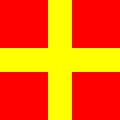Top Qs
Timeline
Chat
Perspective
Na (kana)
Character of the Japanese writing system From Wikipedia, the free encyclopedia
Remove ads
な, in hiragana, and ナ, in katakana, are Japanese kana, which each represent one mora. The hiragana な is made in four strokes, the katakana ナ two. Both represent [na]. な and ナ originate from the man'yōgana 奈. な is used as part of the okurigana for the plain negative forms of Japanese verbs, and several negative forms of adjectives.
This article needs additional citations for verification. (January 2021) |
Remove ads
Stroke order
 |
 |


Other communicative representations
Summarize
Perspective
| Japanese radiotelephony alphabet | Wabun code |
| 名古屋のナ Nagoya no "Na" |
ⓘ |
 |
 |
 | |
| Japanese Navy Signal Flag | Japanese semaphore | Japanese manual syllabary (fingerspelling) | Braille dots-13 Japanese Braille |
- Full Braille representation
Remove ads
References
Wikiwand - on
Seamless Wikipedia browsing. On steroids.
Remove ads

